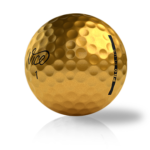Yes, golf balls can get waterlogged. Water can seep into the ball, affecting its performance.
Golfers often wonder if their balls can get waterlogged. The answer is yes, golf balls can absorb water over time. This can affect the ball’s weight, causing it to lose distance and accuracy. Typically, golf balls have a durable outer cover, but prolonged exposure to water can still lead to absorption.
This is especially true for older or damaged balls. To maintain optimal performance, golfers should avoid playing with waterlogged balls. Regularly inspecting and replacing golf balls can help ensure consistency and improve the overall game experience. Keeping golf balls dry and in good condition is crucial for achieving the best results on the course.

The Science Of Golf Balls
Golf balls are fascinating pieces of equipment. They look simple but are made with advanced technology. Understanding the science behind them can help us know if golf balls get waterlogged.
Materials Used
Modern golf balls are made from various materials. The core is usually rubber. This helps in providing the desired bounce and distance.
The cover of the ball is often made from Surlyn or urethane. Surlyn is a durable material that helps the ball last longer. Urethane, on the other hand, offers better control for skilled players.
Construction Process
The construction process of a golf ball is intricate. It involves multiple steps:
- Molding the core from rubber.
- Adding layers for desired performance.
- Applying the cover material.
- Adding dimples for better aerodynamics.
The layers inside the ball are crucial. They affect how the ball performs. Some balls have two layers, while others have three or more. Each layer serves a specific purpose.
Understanding these materials and processes can help explain if golf balls get waterlogged. The rubber core and durable cover materials are designed to resist water. But, over time, even these can get damaged. That could let water seep in, making the ball waterlogged.
What Happens When Golf Balls Get Wet
Golf balls are designed to be durable. But getting wet can affect them. Let’s explore what happens when golf balls get wet.
Immediate Effects
Water can quickly seep into a golf ball’s outer layer. This affects its performance. The ball becomes heavier, reducing its distance. The additional weight can also alter its trajectory. Players may notice a drop in accuracy.
Another immediate effect is on the ball’s spin rate. When wet, the ball may spin less. This influences how it reacts on the green. It might roll differently, making putts harder.
Long-term Impact
Over time, water can penetrate deeper into the ball. This affects the ball’s core. The core is crucial for maintaining energy transfer. A compromised core means less bounce and distance.
Extended exposure to water can lead to permanent damage. The ball may lose its compression. A ball with low compression feels softer. It won’t perform as well as a dry one.
Here’s a summary table of the long-term effects:
| Effect | Impact |
|---|---|
| Core Damage | Less Energy Transfer |
| Reduced Compression | Soft Feel |
| Permanent Weight Gain | Less Distance |
In summary, keeping golf balls dry is essential. Wet balls can impact your game immediately and in the long term.
Can Golf Balls Absorb Water?
Golfers often wonder about the durability of their golf balls. A common question is, Can golf balls absorb water? Understanding this helps in maintaining the performance of the game.
Porosity Of Materials
Golf balls are made from various materials. The outer layer is usually made of a tough, non-porous material like Surlyn or urethane. These materials are designed to be water-resistant. The core is often made of rubber or synthetic compounds. Some of these can absorb small amounts of water.
| Material | Porosity |
|---|---|
| Surlyn | Low |
| Urethane | Low |
| Rubber | Moderate |
| Synthetic Compounds | Moderate |
Water Absorption Tests
Tests have been conducted to check if golf balls absorb water. In these tests, golf balls are submerged in water for several days. The results show minimal water absorption.
Here are some key findings from the tests:
- After 24 hours, less than 0.1% weight gain.
- After 48 hours, about 0.2% weight gain.
- After 72 hours, around 0.3% weight gain.
Water absorption is negligible. This means golf balls do not significantly absorb water. Their performance remains consistent.
Maintaining your golf balls in good condition is essential. Store them in a dry place. Avoid prolonged exposure to water.
Myths Vs. Facts
Golfers often debate if golf balls can get waterlogged. This section will explore common myths and scientific facts to shed light on this topic.
Common Misconceptions
There are many myths about golf balls getting waterlogged. Here are the most common misconceptions:
- Myth: Golf balls absorb water quickly.
- Myth: A waterlogged ball loses its performance.
- Myth: Soaking a ball overnight ruins it.
These myths have been circulating among golfers for years. They often lead to unnecessary worry and confusion.
Scientific Findings
Science provides clarity on whether golf balls get waterlogged. Here are the key findings:
| Fact | Explanation |
|---|---|
| Golf balls have a protective outer layer. | This layer prevents water absorption. |
| Water does not easily penetrate the ball. | Modern materials keep the core dry. |
| Performance remains stable. | Tests show minimal impact from water. |
Tests confirm that water does not significantly affect golf balls. Modern design ensures durability and performance.
Performance Changes In Waterlogged Balls
Golf balls can get waterlogged if left in water for too long. This affects their performance. Let’s explore how waterlogged balls change in terms of distance, accuracy, spin, and control.
Distance And Accuracy
Waterlogged golf balls often lose their distance. The added weight makes them harder to hit far. This can reduce the ball’s flight by several yards.
Accuracy also suffers with waterlogged balls. The uneven weight distribution causes unpredictable flight paths. This makes it harder to control where the ball lands.
| Aspect | Dry Ball | Waterlogged Ball |
|---|---|---|
| Distance | Optimal | Reduced |
| Accuracy | Consistent | Unpredictable |
Spin And Control
Spin is crucial for many golf shots. A waterlogged ball has less spin. This affects shots that need backspin or sidespin.
Control becomes challenging with waterlogged balls. The ball may not respond as expected. This makes it tough to plan shots accurately.
- Backspin is reduced, affecting high shots
- Sidespin is less predictable, impacting curving shots
Using a waterlogged ball can ruin your game. Always check your balls before playing.

Credit: www.tiktok.com
Detecting Waterlogged Golf Balls
Golf balls can get waterlogged. Waterlogged balls affect your game performance. Knowing if a ball is waterlogged helps you choose the right ball.
Signs To Look For
Waterlogged golf balls show specific signs. Look for these signs to detect them:
- Weight: Waterlogged balls feel heavier.
- Distance: They travel shorter distances.
- Sound: They produce a dull sound on impact.
- Appearance: Check for cracks or discoloration.
Simple Tests
Perform these simple tests to check for waterlogged golf balls:
- Float Test: Place the ball in water. If it sinks, it may be waterlogged.
- Spin Test: Spin the ball. Waterlogged balls spin differently.
- Drop Test: Drop the ball from a height. Compare its bounce to a new ball.
Using these methods helps you keep your game sharp. A good ball makes a big difference.
Prevention Tips
Golf balls can get waterlogged. This affects their performance on the course. Knowing how to prevent this is essential. Here are some tips to keep your golf balls in top condition.
Proper Storage
Store your golf balls in a dry place. Moisture can seep into the balls, affecting their quality. Use a sealed container to keep them safe. Make sure the container is airtight.
Avoid storing golf balls in humid areas. Basements and garages often have high humidity levels. Keep golf balls in a cool, dry room. This ensures they stay in good shape.
Handling In Wet Conditions
Play golf in the rain? Take special care of your golf balls. Dry them off frequently with a towel. Keep a dry towel in your golf bag.
Use a golf ball retriever to pick balls from water hazards. This tool helps avoid direct contact with water. Ensure the balls are dry before putting them back in your bag.
| Tip | Description |
|---|---|
| Use Sealed Containers | Keep your golf balls in airtight containers to avoid moisture. |
| Store in Cool, Dry Places | Avoid humid areas like basements and garages. |
| Dry Balls Frequently | Use a towel to keep your golf balls dry during play. |
| Use a Retriever | Avoid direct contact with water by using a retriever. |
Follow these tips to prevent waterlogged golf balls. They will perform better and last longer.
Credit: www.quora.com
Frequently Asked Questions
How Do You Know If A Golf Ball Is Waterlogged?
Check for unusual heaviness or poor performance. Waterlogged golf balls may feel heavier and not travel as far.
Can You Let Golf Balls Soak In Water?
Soaking golf balls in water can damage their performance. Water can seep into the core, affecting distance and accuracy.
Do Wet Golf Balls Make A Difference?
Yes, wet golf balls affect performance. They reduce distance and accuracy due to increased drag and reduced friction. Dry your golf balls for optimal play.
How Do You Test Golf Balls In Water?
To test golf balls in water, fill a bucket with water and gently place the golf balls in. Observe if they float or sink. Floating balls are likely damaged or have defects.
Conclusion
Waterlogged golf balls can significantly impact your game. It’s essential to keep them dry and store them properly. Regularly check for water damage to maintain performance. Using high-quality, well-maintained golf balls ensures better accuracy and distance. Stay mindful of these tips to enjoy a more consistent golfing experience.





